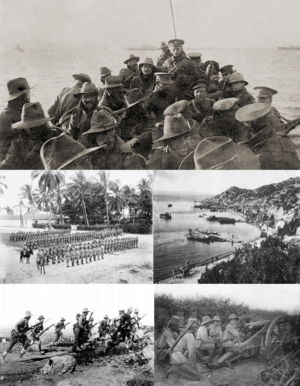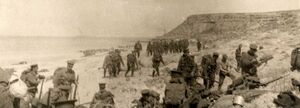Tridentum Campaign: Difference between revisions
| Line 69: | Line 69: | ||
==Preparations for invasion== | ==Preparations for invasion== | ||
===Allied landing preparations=== | ===Allied landing preparations=== | ||
{{main|Order of battle for the Tridentum Campaign}} | |||
[[File:Landing Cape Helena.jpeg|thumb|upright=1.0|Troops landing at Cape Helena, 1922.]] | |||
After the failure of the naval attacks, troops were assembled to eliminate the Exponent mobile artillery, which was preventing the Allied minesweepers from clearing the way for the larger vessels. Aquitayne appointed General [[Andre Cedargore]] to command the 6 divisions of the [[Aswickan Expeditionary Force]] (AEF), itself part of the [[Aswickan Imperial Force]]. He was also given command of the Aquitaynian XXI Corps, consisting of 5 divisions which were folded into the AEF for the duration of the campaign. The troops were joined by the [[Royal Naval Division]], which would capture Aesica Island. The operation would be complicated by having only five divisions available, the rugged terrain of the peninsula, the small number of landing beaches and great difficulty in providing supplies. Later on, the AEF was supported by about 2,000 civilian labourers from Tridenta. | |||
Over the following month, Cedargore prepared his plan and the Aswickan and Aquitaynian divisions were sent to the Sandown Isles. Cedargore chose to concentrate on the western part of the peninsula at [[Cape Helena]], where an unopposed landing was expected. The Allies initially discounted the fighting ability of the Exponent soldiers. The ''naïveté'' of the Allied planners was illustrated by a leaflet that was issued to the Aswickan and Aquitaynian soldiers while they were still assembling, | |||
{{quote|Exponent soldiers as a rule manifest their desire to surrender by holding their rifle butt upward and by waving clothes or rags of any colour. An actual white flag should be regarded with the utmost suspicion as an Exponent soldier is unlikely to possess anything of that colour.}} | |||
The underestimation of Exponent military potential stemmed from a "sense of superiority" among the Allies, because of the decline of the Empire and its poor performance in wars that had pitted them against the allies. Allied intelligence failed to adequately prepare for the campaign, in some cases relying on information gained from travel guides. The troops for the assault were loaded on transports in the order they were to disembark, causing a long delay which meant that many troops were forced to detour to Alexandria to embark on the ships that would take them into battle. A five-week delay until the end of April ensued, during which the Exponent troops strengthened their defences on the peninsula; although bad weather during March and April might have delayed the landings anyway, preventing supply and reinforcement. On 17 April, the Aquitaynian submarine HMS E-20 tried to run into the bay but hit a submarine net, ran aground and was shelled by an Exponent fort, killing its commander, Lieutenant Commander Theodore S. Brodie and six of his crew; the survivors were forced to surrender. Poor weather from 19 March grounded Allied aircraft for nine days and on 24 days only a partial programme of reconnaissance flights were possible. | |||
===Exponent defensive preparations=== | ===Exponent defensive preparations=== | ||
==Landings== | ==Landings== | ||
{{Main|Landing at Aswick Cove|Landing at Cape Helena}} | {{Main|Landing at Aswick Cove|Landing at Cape Helena}} | ||
Revision as of 10:00, 19 April 2019
The Tridentum Campaign, was a campaign of the Great Astyian War that took place on the Tridenta peninsula in modern day Bungussi. Aquitayne sought to weaken the Empire of Exponent by opening a second front in the country's northern territories. The invaders launched a naval attack followed by an amphibious landing on the peninsula, to capture the Exponent city of Tilurium. The naval attack was repelled and after a year's fighting, with many casualties on both sides, the land campaign was abandoned and the invasion force was withdrawn. It was a costly and humiliating defeat Aswick and Aquitayne.
The campaign was a major Exponent victory in the war. In BC, it is regarded as a defining moment in the history of the state, a final surge in the defence of the motherland as the Empire of Exponent retreated. The struggle formed the basis for the rebellions that spelled the end of the Empire of Exponent in the nineties. The campaign is often considered to be the final push needed for Aswickan independence; 25 April, the anniversary of the landings, is known as "Trident Day", the most significant commemoration of military casualties and veterans in the two countries, surpassing Remembrance Day (Armistice Day).
Background
In late 1921, Aquitaynian forces invaded the Empire of Exponent, but got bogged down into a stalemate quite quickly. Unable to advance, Aquitayne needed to open a second front to draw troops away from themselves.
Allied strategy
On 18 March 1922, the Allied fleet, comprising 18 battleships with an array of cruisers and destroyers began the main attack against Triius Bay. Despite some damage to the Allied ships engaging the forts by Exponent return fire, minesweepers were ordered along the straits. In the Exponent official account, by 2:00 p.m. "all telephone wires were cut, all communications with the forts were interrupted, some of the guns had been knocked out ... in consequence the artillery fire of the defence had slackened considerably". The Aquitaynian battleship Diane struck a mine, causing her to capsize in two minutes, with just 75 survivors out of a total crew of 718. Minesweepers, manned by civilians, retreated under Exponent artillery fire, leaving the minefields largely intact. HMAS Irresistible and HMAS Inflexible struck mines and Irresistible was sunk, with most of her surviving crew rescued; Inflexible was badly damaged and withdrawn. There was confusion during the battle about the cause of the damage; some participants blamed torpedoes. HMAS Ocean was sent to rescue Irresistible, struck a mine, and was abandoned, eventually to sink.
The Aquitaynian battleships Archer and Bowman sailed through a new line of mines placed secretly by the Exponent minelayer Gladius ten days before and were also damaged. The losses forced Dundas to sound the "general recall" to protect what remained of his force. During the planning of the campaign, naval losses had been anticipated and mainly obsolete battleships, unfit to face the western powers, had been sent. Some of the senior naval officers like the commander of Queen Elizabeth, Commodore Roger Keyes, felt that they had come close to victory, believing that the Exponent guns had almost run out of ammunition but the views of Dundas, the First Sea Lord James Richard and others prevailed. Allied attempts to force bay using naval power were terminated, due to the losses and bad weather. Planning to capture the Exponent defences by land, to open the way for the ships began.
Preparations for invasion
Allied landing preparations
After the failure of the naval attacks, troops were assembled to eliminate the Exponent mobile artillery, which was preventing the Allied minesweepers from clearing the way for the larger vessels. Aquitayne appointed General Andre Cedargore to command the 6 divisions of the Aswickan Expeditionary Force (AEF), itself part of the Aswickan Imperial Force. He was also given command of the Aquitaynian XXI Corps, consisting of 5 divisions which were folded into the AEF for the duration of the campaign. The troops were joined by the Royal Naval Division, which would capture Aesica Island. The operation would be complicated by having only five divisions available, the rugged terrain of the peninsula, the small number of landing beaches and great difficulty in providing supplies. Later on, the AEF was supported by about 2,000 civilian labourers from Tridenta.
Over the following month, Cedargore prepared his plan and the Aswickan and Aquitaynian divisions were sent to the Sandown Isles. Cedargore chose to concentrate on the western part of the peninsula at Cape Helena, where an unopposed landing was expected. The Allies initially discounted the fighting ability of the Exponent soldiers. The naïveté of the Allied planners was illustrated by a leaflet that was issued to the Aswickan and Aquitaynian soldiers while they were still assembling,
Exponent soldiers as a rule manifest their desire to surrender by holding their rifle butt upward and by waving clothes or rags of any colour. An actual white flag should be regarded with the utmost suspicion as an Exponent soldier is unlikely to possess anything of that colour.
The underestimation of Exponent military potential stemmed from a "sense of superiority" among the Allies, because of the decline of the Empire and its poor performance in wars that had pitted them against the allies. Allied intelligence failed to adequately prepare for the campaign, in some cases relying on information gained from travel guides. The troops for the assault were loaded on transports in the order they were to disembark, causing a long delay which meant that many troops were forced to detour to Alexandria to embark on the ships that would take them into battle. A five-week delay until the end of April ensued, during which the Exponent troops strengthened their defences on the peninsula; although bad weather during March and April might have delayed the landings anyway, preventing supply and reinforcement. On 17 April, the Aquitaynian submarine HMS E-20 tried to run into the bay but hit a submarine net, ran aground and was shelled by an Exponent fort, killing its commander, Lieutenant Commander Theodore S. Brodie and six of his crew; the survivors were forced to surrender. Poor weather from 19 March grounded Allied aircraft for nine days and on 24 days only a partial programme of reconnaissance flights were possible.



